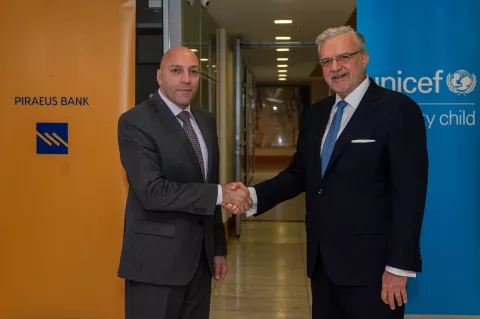Greek photographer, Angelos Tzortzinis, receives award of "Photography of the Year 2020" from UNICEF
Six months after the catastrophic fire at the Moria RIC, we discuss the power of photography with the award-winning photographer Angelos Tzortzinis

- Available in:
- Ελληνικά
- English
Six months after the catastrophic fire at the refugee and migrant Reception and Identification Centre in Moria, Lesvos, we spoke with award-winning photographer Angelos Tzortzinis on the power of photography in informing and raising public awareness.
Acclaimed Greek photographer Angelos Tzortzinis, received UNICEF's “Photo of the Year 2020” * award for the series of iconic photographs, documenting the disastrous fire that broke out in the Reception and Identification Center of Moria, in Lesvos, on September 9, 2020.
“The image of a small child holding a younger one in his arms to save him, then both of them running together to get away from the flames that chase them, is an image that can trigger many emotions, such as horror, sadness and outrage…"
“The image of a small child holding a younger one in his arms to save him, then both of them running together to get away from the flames that chase them, is an image that can trigger many emotions, such as horror, sadness and outrage…But for me, standing there, what really struck me was the realization that such a thing was really happening right in front of me, in Greece, in Europe, and that it is incredibly cruel…”, says Angelos Tzortzinis about his photos, which constitute pieces of staggering evidence of the moments of agony that thousands of people and children went through while attempting to flee the destructive flames which rampaged across Europe’s largest refugee facility. Over 12,000 people, among whom 4,000 children, were left homeless once more.

Angelos Tzortzinis studied photography in Leica Academy, Athens and has collaborated as a photographer with various international media outlets, such as The New York Times, Newsweek, the Herald Tribune and news agencies such as Agence France Presse (AFP). He also worked in a number of photographic projects covering developments in Haiti, Georgia, Egypt, Turkey and Greece, for over a decade.
In the previous years he dedicated a significant part of his work to the documentation of the refugee situation in Greece, in an exceptionally consistent and penetrating manner. Some of his most prominent awards, among many national and international distinctions, include his “Βest Wire Photographer” award by “TIME” magazine in 2015, for his photographs highlighting the refugee crisis on the Aegean islands as well as the different aspects of the financial crisis in Greece. He was also among the photographers which Magnum, one of the most prestigious photographic foundations globally, chose to award for the year 2016.
“This particular award is a great honor for me, especially coming from an organization like UNICEF. Above all else, I would like to believe that a photograph might have this small power, to give the opportunity, even to one person, to think a little harder, to contemplate and maybe feel motivated to do something…If this happens, I will be truly happy”.

Over 1,5 million refugees and migrants reached Greece since 2015, seeking asylum and a better life in Europe, away from war and conflict. Among them, it is estimated that only around 70,000 are in Greece today. Among them, 45,000 children.
Currently, following a number of relocation missions, the numbers in the new temporary Reception Center in Lesvos have been reduced to 7,500. Despite the ongoing efforts of the Greek government and international institutions, living conditions for children and families remain miserable, as challenging weather deteriorates the picture, while at the same time obstructing the work of the competent institutions and authorities.
UNICEF, in collaboration with international, state and independent institutions, supports thousands of migrant and refugee children living on the Greek islands and in mainland Greece, with project interventions in the framework of child protection and non-formal education, combatting gender based violence and distributing hygiene material to vulnerable children and families.
*Since 20 years, the German National Committee awards the “UNICEF Photo of the Year” to photographs and photographic projects which capture in an extraordinary way the personality and living conditions of children around the world. Only professional photographers participate in the contest, following recommendation by internationally acclaimed experts in the field of photography.




